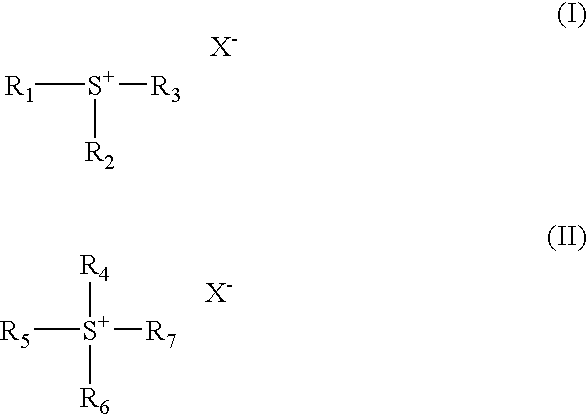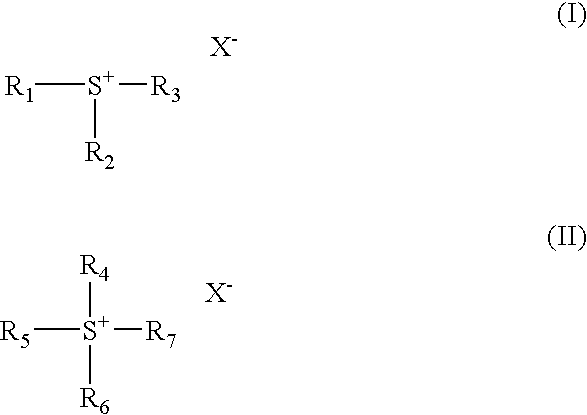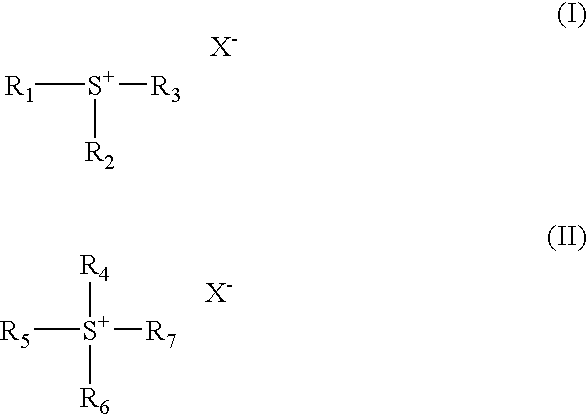Thermally developable materials processable at lower temperatures
a technology of developable materials and induction period, applied in the field of thermo-developable materials, can solve the problems of continued failure for a number of years, and achieve the effects of improving the rate of development, reducing the induction period of development, and improving the temperatur
- Summary
- Abstract
- Description
- Claims
- Application Information
AI Technical Summary
Benefits of technology
Problems solved by technology
Method used
Image
Examples
##ventive examples 1-6
INVENTIVE EXAMPLES 1-6
[0225] These examples were prepared similarly to that of Comparative Example 1 except that 10 mol % (relative to silver) of the quaternary phosphonium or tertiary sulfonium cationic salt given in TABLE I below was added just prior to the first sonication.
##ventive example 7
INVENTIVE EXAMPLE 7
[0232] This example was prepared similarly to that of Comparative Example 4 except that 38 mg of trimethylsulfonium methyl sulfate (0.2 mmol) was added prior to the first sonication.
[0233] Coating Processing and Data:
[0234] The individual coatings were cut into small strips for a determination of the development-density produced at various process temperatures (20° C. and 100 to 170° C. in 5° C. increment) for development times of 5, 10, 15, and 20 seconds. The strips were immersed in silicone oil at the desired temperature for the desired time. They were then rinsed in hexane and the resulting density was read using a combination of Status A filters as a visual density using a Macbeth TD504 densitometer and the appropriate filters (see T. H. James, The Theory of the Photographic Process, 4th Ed., Macmillan Publishing Co., Inc., N.Y., 1977, page 521 for details of this process). The density vs. temperature plot was constructed for each of the four development ti...
##ventive example 8
INVENTIVE EXAMPLE 8
[0238] To a 30 ml beaker were added 987 mg (2.0 mmol) of silver behenate, 0.20 g of BUTVAR® B79 polyvinyl butyral resin, 38 mg of trimethylsulfonium methyl sulfate and 17 g of methyl ethyl ketone (MEK). The beaker was placed in an ice-water bath and sonicated for 3 minutes using a Sonifier® Cell Disruptor 350 equipped with a 0.75 inch (1.9 cm) probe tip and set on 50% duty cycle and 5.5 power output (the ice-water bath maintained the mixture at temperatures near 20° C. during sonication).
[0239] Red safe lights were then used throughout the remainder of this example.
[0240] A solution of 45 mg of zinc bromide dissolved in 1 ml of methanol was added to the stirred mixture over about 1 minute (the zinc bromide in the presence of silver behenate resulted in the formation of silver bromide that served as the light sensitive photocatalyst). After stirring for 10 minutes, 0.285 g of 2,3-dihydroxybenzoic acid were added and the mixture was stirred for 20 minutes. Then, 2...
PUM
| Property | Measurement | Unit |
|---|---|---|
| temperature | aaaaa | aaaaa |
| particle size | aaaaa | aaaaa |
| particle size | aaaaa | aaaaa |
Abstract
Description
Claims
Application Information
 Login to View More
Login to View More - R&D
- Intellectual Property
- Life Sciences
- Materials
- Tech Scout
- Unparalleled Data Quality
- Higher Quality Content
- 60% Fewer Hallucinations
Browse by: Latest US Patents, China's latest patents, Technical Efficacy Thesaurus, Application Domain, Technology Topic, Popular Technical Reports.
© 2025 PatSnap. All rights reserved.Legal|Privacy policy|Modern Slavery Act Transparency Statement|Sitemap|About US| Contact US: help@patsnap.com



